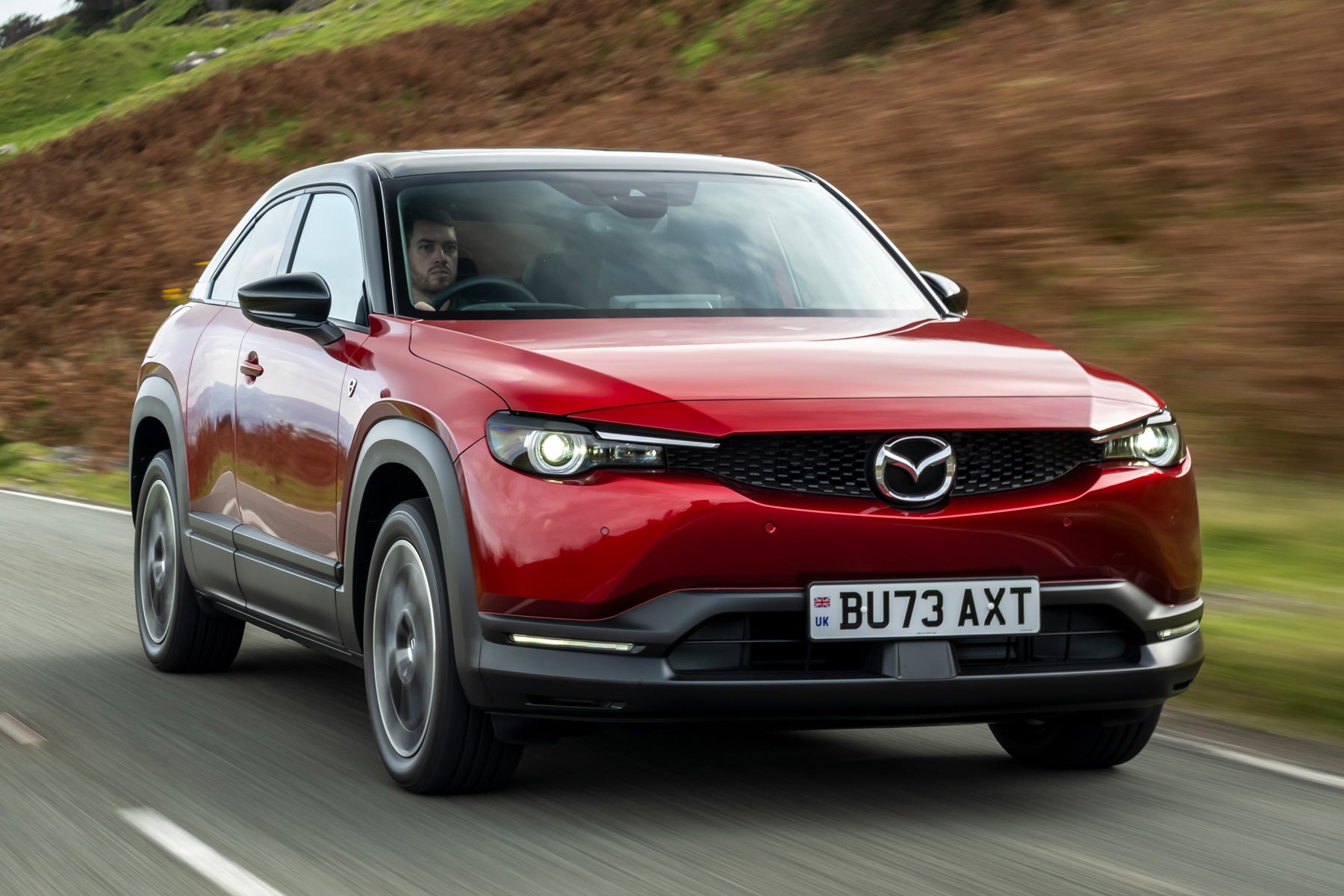Mazda MX-30 Review 2025: Price, specs & boot space
Written by Andrew Brady
Quick overview
Pros
- Cool cabin with sustainable materials
- The electric model is fun to drive
- Represents good value for money on the used market
Cons
- Poor range from EV
- Range-extender is unrefined and not that efficient
- Strange doors make access to the rear tricky
Verdict: Is the Mazda MX-30 a good car?
"Yet again, Mazda does things its own way. The all-electric Mazda MX-30 has a small range, while the MX-30 R-EV range extender is an interesting alternative to more conventional plug-in hybrid SUVs. The MX-30 won't be for everyone, but we're glad it exists."
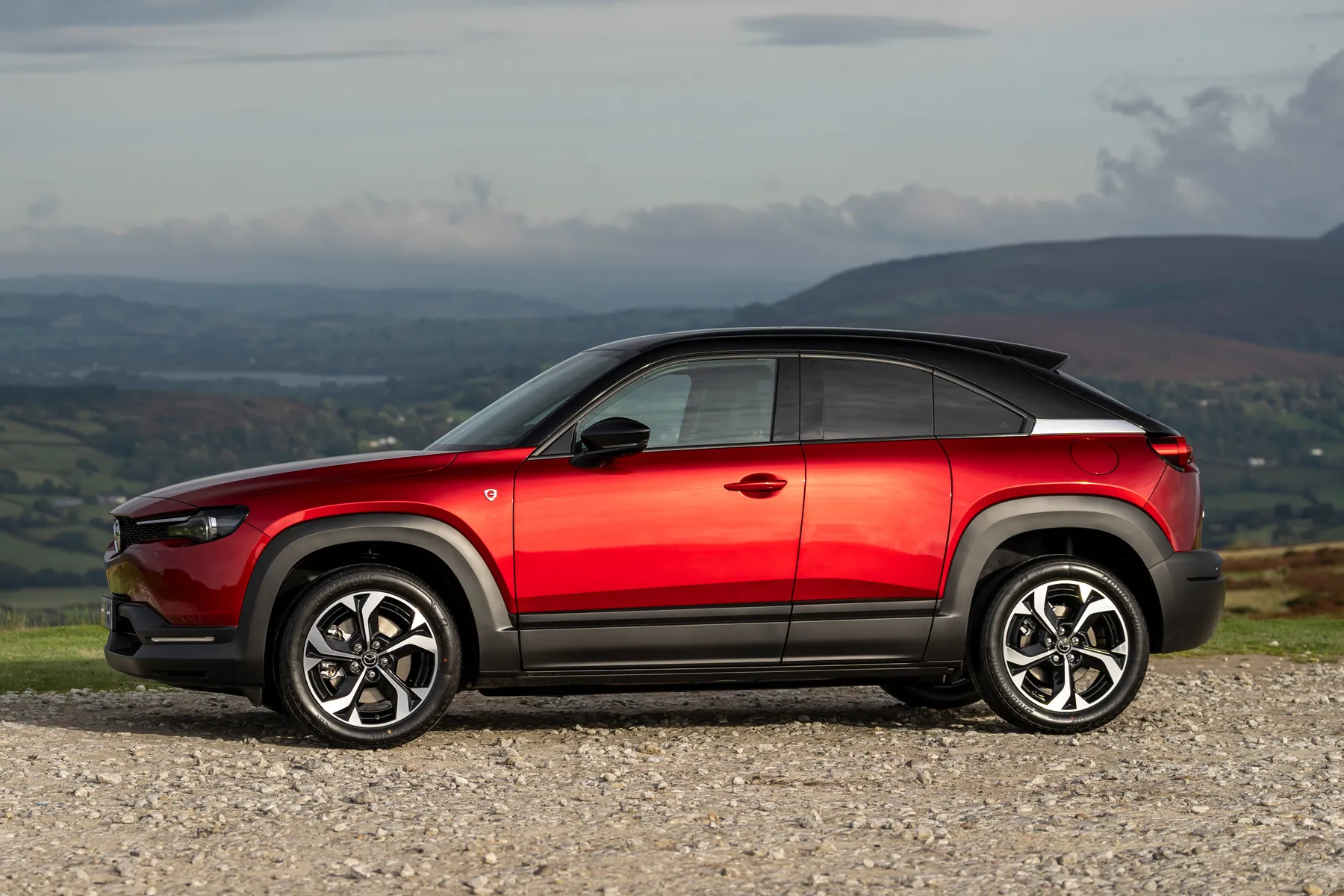
The Mazda MX-30 arrived in 2020 as a small, all-electric SUV with an equally small battery pack. Its 124-mile range raised eyebrows, especially as that equates to barely 100 miles in the real world. But we need to get over this obsession with range: the average journey for a Mazda driver is just 26 miles - so why lug around a heavy battery if you don't need to travel that far..?
A big update arrived in 2023, when a new longer-range Mazda MX-30 arrived. No, Mazda didn't fit a bigger battery like you'd find in a Kia Niro EV or Volkswagen ID.3. Instead, it added a tiny little engine that acts as a range extender (a bit like the old BMW i3) as an option. This doesn't power the front wheels - instead, it's there simply to charge the battery when necessary. And to add an extra element of curiosity, the engine is a rotary unit, similar to those used in some of Mazda's now legendary sports cars including the RX-7 and RX-8.
You'll be able to cover around 50 miles in the Mazda MX-30 R-EV before the petrol engine fires into life. That's ideal if you've got a short commute (or school run) yet want the ability to travel further at weekends without having to stop for a charge. And, unlike a lot of 'normal' plug-in hybrids, the MX-30 R-EV can be rapid charged - meaning you can top up the battery at the motorway services when you stop for a coffee.
Whether you choose the range-extender model (badged the Mazda MX-30 R-EV) or the regular electric car (the Mazda MX-30 EV), you'll probably enjoy driving it. With its direct steering, it's evident that the engineers behind the MX-30 are the same people responsible for the Mazda MX-5. It's not quick, though, while the R-EV lacks the refinement of a standard electric car. In fact, it's really rather noisy.
The Mazda MX-30's interior is lovely. Or it is for those in the front, anyway. You get a superb seating position, along with a range of classy materials and an easy-to-use infotainment system. Access to the back is hindered by the rear-hinged doors which are a talking point but also a little annoying in everyday use. There's a reason they haven't caught on but, if you mainly use the MX-30 as a two-seat city car, it's perfectly practical.
As of 2023, the Mazda MX-30 range is made up of three trim levels: Prime-Line, Exclusive-Line and Makoto. All are well-equipped, with features such as 18-inch alloy wheels, an 8.8-inch media system (with Apple CarPlay and Android Auto) and radar cruise control standard across the range.
Prices start from around £28,000 for the EV and £31,500 for the R-EV, while top-spec models are in the £32,00 and £36,000 ball parks, respectively.
Looking for a used car for sale? We've got 100s of Mazda Approved Used Cars for Sale for you to choose from, including a wide range of Mazda MX-30 cars for sale.
Is the Mazda MX-30 right for you?
The Mazda MX-30 is an interesting alternative to more conventional electric cars. The limited range of the EV will be an issue for some, but for running around town or taking the kids to school, a used Mazda MX-30 EV could be a great purchase. The Mazda MX-30 R-EV will appeal to those wanting to travel furtherafield, but we'd suggest looking at a longer-range EV instead.
What is the best Mazda MX-30 model/engine to choose?
We reckon the Mazda MX-30 makes the most sense as a used purchase. Bag an early Mazda MX-30 EV and you can be driving around in an interesting, quirky electric car for the price of a used Ford Fiesta. In terms of trim levels, all are pretty well-equipped... look for a GT Sport Tech as a used buy for such luxuries as an opening sunroof, Bose sound system and heated steering wheel.
What other cars are similar to the Mazda MX-30?
While there's no shortage of electric (and hybrid) cars to choose from, the Mazda MX-30 takes a slightly different approach to a lot of competitors. In some ways, it's a rival to fashionable electric city cars like the Honda e and MINI Electric, yet it also squares up against SUV rivals such as the Kia Niro and Hyundai Kona. We'd also suggest looking at the Volkswagen ID.3 and Cupra Born as well as Chinese competitors such as the MG4 EV and Ora Funky Cat.
Comfort and design: Mazda MX-30 interior
"The Mazda MX-30’s driving position is excellent. The seats are supportive yet comfortable while the raised ride height offers a better view of the road. The seats and steering wheel also plenty of adjustment so it’s easy to find a position that feels natural."
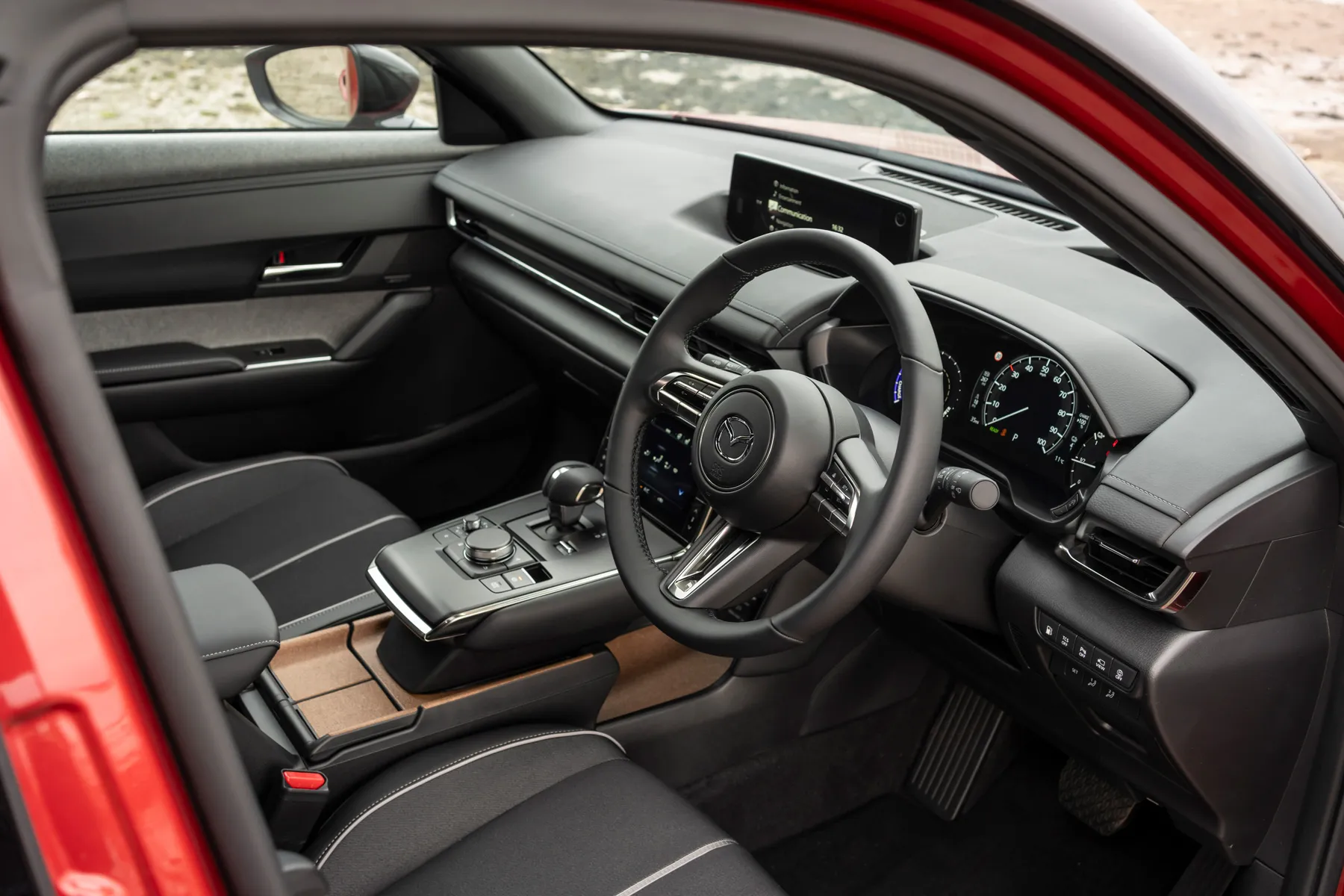
Some people might complain about the Mazda’s lack of a touchscreen. Here, the 8.8-inch centre console display is controlled by a rotary dial. Personally, we feel this is a much better option than taking your eyes off the road and leaning across to jab your index finger at a constantly moving target. Although not everyone agrees…
Curiously, Mazda has added a seven-inch touch screen below for the air-con and heating controls. This is rendered almost pointless, due to the inclusion of physical buttons alongside it. However, it does look quite cool and gives the cabin a slightly high-tech feel.
And then there's the floating centre console which is intrusive and also a little bit unnecessary. It doesn’t really offer any useful space behind it - although it does bring some of the controls closer to the driver.
Quality and finish
Hats off to the design team for their focus on sustainable cabin materials. You’ll find cork dotted all over the cabin. Sourced from left-over bottle stoppers, no trees are cut down to make the cork (instead the bark of the tree is stripped away). This means it is low-impact and environmentally sustainable.
It’s not just the cork, either. The upper door trim uses recycled fabric, specifically recycled plastic bottles. Unlike the cork, it doesn’t leap out at you and it definitely doesn’t make the cabin feel cheap, unfinished or badly put together. We can’t vouch for how well it’ll hold up over the life of the car, though.
Does it work from a design point of view? The jury’s still out on that. Initially, it’s quite jarring – the contrast of the dark plastics against the light, grainy cork. But as you spend more time with the car you do get used to it. And it’s certainly a talking point.
Infotainment: Touchscreen, USB, nav and stereo in the Mazda MX-30
While it might not be as slick as some of its German rivals, the Mazda’s infotainment system certainly isn’t bottom of the league. It’s a solid performer that offers everything you need in a way that’s easy to find.
Early examples were slow to start up, but that seems to have been sorted while the support for Apple CarPlay and Android Auto will be welcomed by drivers who prefer to use their own familiar tech like Waze and Spotify.
The MyMazdaApp promises to notify drivers if they haven’t plugged in the charging cable, and give them the ability to set charge times to take advantage of off-peak electricity. And, of course, they’ll be able to see how much charge is left in the battery as well as remotely switch the heating on. Handy.
But the thing that we, personally, always appreciate is the Bose sound system, which offers excellent audio sound and in this car allows you to make the most of the EV’s peace and quiet. However, you'll need the top-spec Mazda MX-30 Makoto for this.
Space and practicality: Mazda MX-30 boot space
Let's start with those doors. The rear doors open backwards - a nod to the old RX-8 - supposedly allowing easy access for rear-seat passengers. You have to slide the front seats forward for an adult to climb in, though - and it's a bit of a faff that you don't get with normal doors. It's a bit of a novelty, although we don't quite buy into Mazda's claims that the so-called 'freestyle' doors give the MX-30 a sense of space. It actually feels quite claustrophobic in the rear; not least because the rear windows don't open. The Mazda CX-30 - which is almost identical in size to the MX-30 - feels much roomier inside.
Still, if you're not planning on carrying rear-seat passengers regularly, the Mazda MX-30 is a perfectly useable electric vehicle. The 350-litre boot is a good size, while there isn't much of a load lip. When you drop the rear seats, the space is almost flat. As a two-seater with a big boot, the Mazda MX-30 is great.
If you're planning to squeeze the Mazda MX-30 into your garage, you'll want to know the exterior dimensions. It's 4395mm long, 1795mm wide and 1570mm high.
Handling and ride quality: What is the Mazda MX-30 like to drive?
"It's an exaggeration to say that the MX-30 is the sports car of the electric SUV world, but it certainly handles pretty well for what it is. And that doesn't come at the expense of comfort, which is nice."
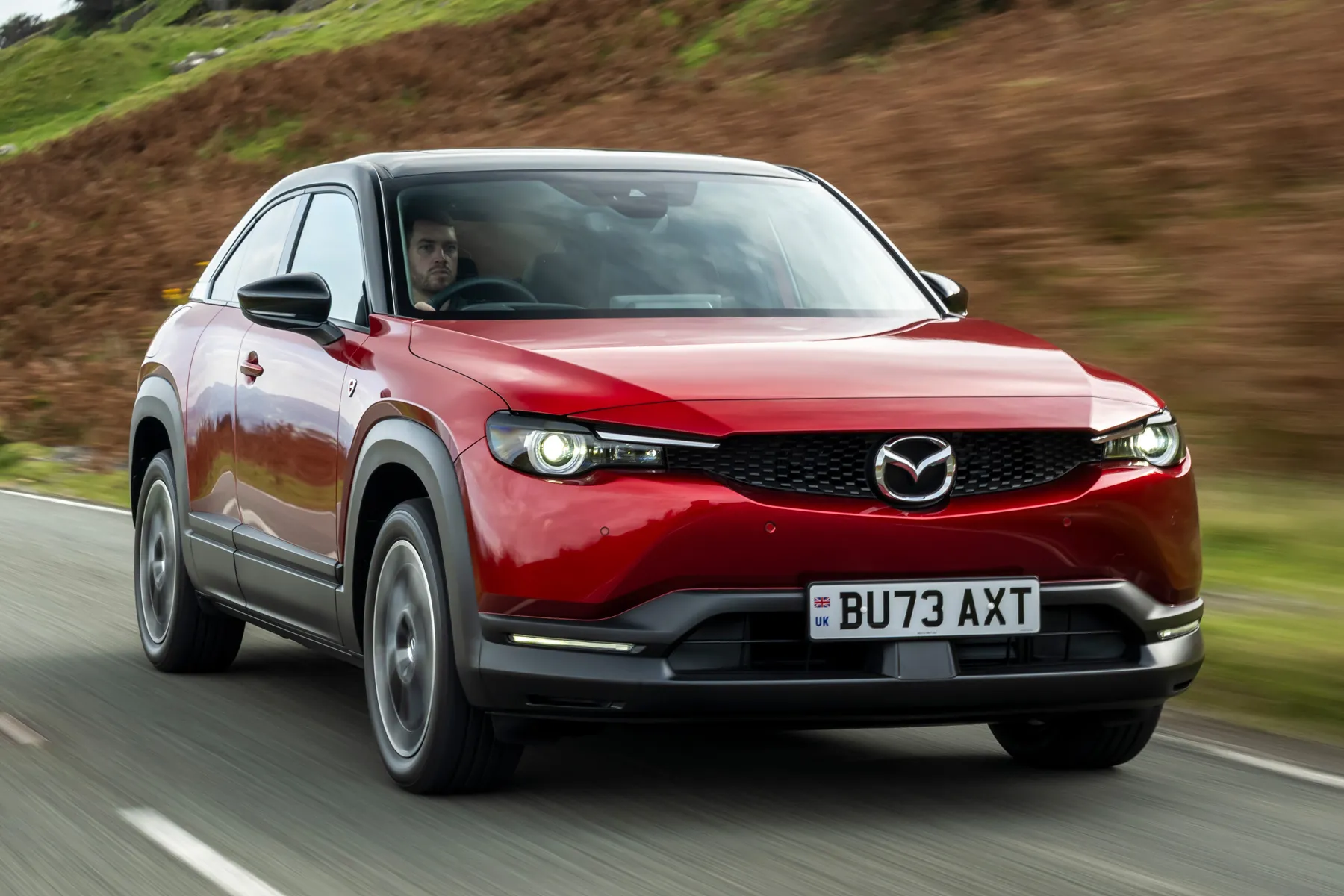
Mazda's benchmarked cars like the MINI Electric in the handling department, and it's certainly clear that handling is more of a priority than for, say, the Hyundai Kona Electric or Nissan Juke Hybrid. It's quite fun to chuck around, although - more importantly for a car like this - it's also easy to drive in town.
All Mazda MX-30 models come with front and rear parking sensors, as well as a reversing camera, while the top-spec MX-30 has a very handy 360-degree camera system. Parking will no longer be your nemesis.
Both the full electric version and the range extender get paddles behind the steering wheel, allowing you to increase the regenerative braking at your will. This changes how much the MX-30 slows down when you lift off the acceleration; with it ramped up to the max, you won't need to touch the brakes quite so often - although it doesn't quite provide one-pedal driving.
What motors and batteries are available in the Mazda MX-30?
There are two key variants of Mazda MX-30 on offer, and both take a slightly different approach to competitors.
First up is the regular electric Mazda MX-30. This has been on sale since 2020 and uses a relatively small 35.5kWh battery pack. The advantage of this is it's kinder to the environment (manufacturing a big battery that you don't really need is considered wasteful), while it's also cheaper and quicker to charge. The disadvantage, obviously, is you can't travel as far between charges.
This battery is paired up with a single motor, providing 145PS and relatively sedate 0-62mph acceleration in 9.7 seconds. While other electric cars feel quicker, it's on par with a typical family hatchback, while the instant response of the electric motor means it feels suitably peppy - certainly around town.
Next is the Mazda MX-30 R-EV, introduced in 2023. This is basically a plug-in hybrid, although it's different from other PHEVs in a number of ways. The wheels are driven exclusively by the electric motor as the tiny petrol engine acts as a generator. It's also a rotary engine - something that Mazda's experimented with in the past with limited success. The Mazda RX-8 had one, and that's a car with a sub-optimal reliability record.
Unlike the RX-8, the Mazda MX-30 R-EV definitely isn't a sports car. It's only slightly quicker than the electric version, accelerating to 62mph in 9.1 seconds. Top speed is 87mph.
Mazda MX-30 range: How far can you go on a charge?
Mazda says the MX-30’s battery range is good for 124 miles, but we reckon around 100 miles is more achievable in the real world. If you cover a lot of longer journeys, you might want to consider an alternative like the Volkswagen ID.3 or Hyundai Kona Electric instead.
Servicing data from Mazda reveals that MX-30 owners only cover around 130 miles a week on average, though, so its limited range isn't necessarily an issue. If you're only using it for the school run or a short commute, you might only need to plug it in once or twice a week.
The Mazda MX-30 R-EV has a pure electric range of 53 miles - more than enough for the average journey length in the UK, says Mazda. Like most plug-in hybrids, it's ideal for those drivers who want electric motoring around town, but the back up of a petrol engine for longer journeys. With 37.2mpg combined economy officially claimed and a 50-litre fuel tank, the R-EV has a potential driving range of around 400 miles.
Refinement and noise levels
If you're looking for a peaceful driving experience, the all-electric Mazda MX-30 is the one to go for. Like other electric vehicles, it's generally a refined companion, although you will notice a bit of a roar from the tyres. There's some virtual engine noise piped in, too, to add a (perhaps unwanted...) sense of sportiness.
At times, the Mazda MX-30 R-EV also does a good impression of a hushed little SUV. But then there are times, when the battery's flat, that the rotary engine roars away at a seemingly excessive amount of revs. It actually sounds pretty unpleasant.
Safety and equipment: How safe is the Mazda MX-30?
The MX-30 is loaded with both active and passive safety equipment with its smart brake support grabbing the headlines. This system, which already helps mitigate (definition ‘make less severe’) against vehicle, pedestrian and bicycle collisions now includes a turn across traffic function.
That means when you turn right in a right-hand drive car the sensors will slam the brakes on if they pick up on something the driver hasn’t spotted. Along with lane keep assist and blind spot assist, occupants will feel well looked after. Or they could have just improved visibility.
Here, Mazda is trying to offset any potential worries caused by a missing B-pillar in the middle of the car. As well as reinforcing the roof and the sills, the structure has been designed to absorb an impact and diffuse the energy. In the event of a collision, the drive system shuts down while the batteries are enclosed in a case to protect occupants from electric shocks.
Of course, there are more familiar systems on board such as adaptive LED headlights, adaptive cruise control and driver monitoring. All of which helped it score five out five in the Euro NCAP crash test.
Mazda MX-30 charging times: How much does it cost to charge?
"While the Mazda MX-30 might not have the longest range, its tiny battery can be charged quickly. It won't hit your electricity bill too hard, either for each charge."

A 7kW home charger will completely charge the electric Mazda MX-30 in around five hours or so, at a cost of about £10 (depending on your home electricity tariff). The Mazda MX-30 R-EV, with its small 17.8kWh battery pack, can be topped up using the same charger in just an hour and a half.
When you're out and about, a 50kW public rapid charger can top up the Mazda MX-30 EV from 20-80% in less than half an hour. And, unlike most conventional plug-in hybrids, the Mazda MX-30 R-EV can also be rapid-charged. A 36kW charger will top up the battery in around 25 minutes.
Whether doing so makes financial sense is another matter. The most convenient public rapid chargers are also quite expensive, so it might be worth just running the Mazda MX-30 R-EV from its petrol engine instead.
Mazda MX-30 reliability and warranty
Mazda generally has an excellent reliability record and - with fewer moving parts to go wrong - the electric MX-30 should be more dependable than a petrol or diesel equivalent.
While the car comes with Mazda's standard three-year warranty, the battery is covered for eight years or 100,000 miles.
Mazda MX-30 insurance groups and costs
All Mazda MX-30 EVs sit in insurance group 19, while the range-extender MX-30 R-EV is in insurance group 22 or 23 (depending on trim level). That ought to make the MX-30 relatively affordable to insurance compared to rivals. Shop around for quotes, though - some insurance companies still charge a premium for electric vehicles.
VED car tax: What is the annual road tax on a Mazda MX-30?
Buy a pure electric Mazda MX-30 and you won't pay any car tax until 2025 when first-year road tax costs £10. After that, you'll pay £195 per year.
The Mazda MX-30 R-EV currently costs £110 for the initial year's road tax, and then £195 every 12 months after that.
Mazda MX-30 price
"Like a lot of electric cars, used Mazda MX-30 values have plummeted quite dramatically. That means, if you're not fussed about driving a brand new car, you can grab a bargain on the used market."
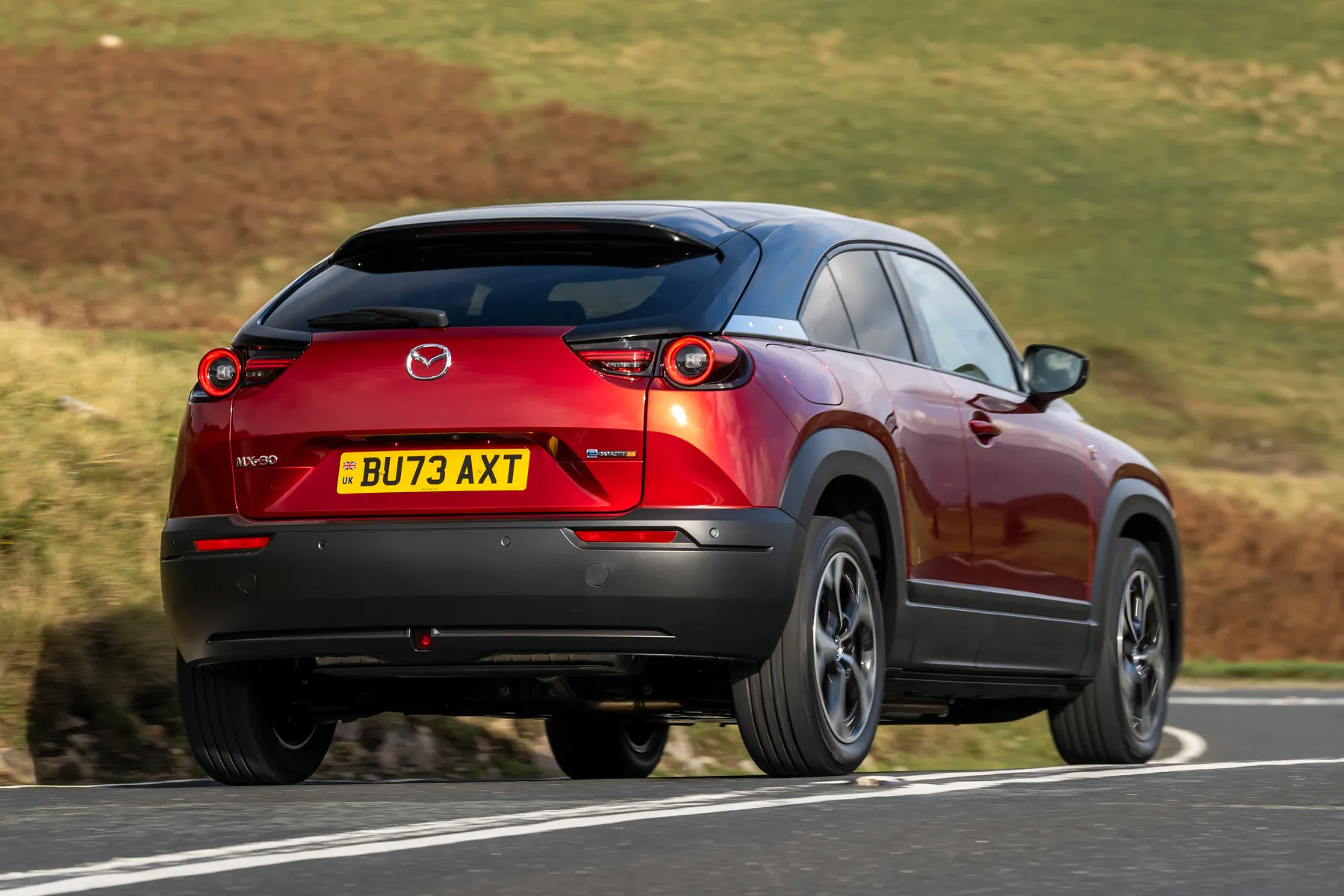
Despite being just a few years old, early examples of the Mazda MX-30 are now down to £10,500 - that's around a third the price of a new one. For this kind of money, a used Mazda MX-30 makes a great urban runaround - it's certainly more interesting than, say, a used Vauxhall Corsa Electric.
If you do want a new Mazda MX-30, on-the-road prices start from around £28,000 for the EV. The range-extender Mazda MX-30 R-EV costs from £31,500.
These prices mean the Mazda MX-30 is one of the more affordable electric cars you can buy, undercutting longer-range rivals like the Kia Niro EV and Volkswagen ID.3. If you do wish to have your cake and eat it, the MG4 EV manages to have both a longer range than the Mazda MX-30 and a comparable price tag.
Trim levels and standard equipment
Standard equipment on the entry-level Mazda MX-30 Prime-Line includes 18-inch alloy wheels (silver on EV; grey on R-EV), and black exterior highlights. This trim also has rain-sensing wipers, high-beam control, LED headlights, plus a light grey cloth interior, seven-inch climate control touchscreen, seven-inch digital instrument cluster, and an 8.8-inch navigation system with Apple CarPlay and Android Auto.
The Prime-Line comes with climate control, front electric windows, radar cruise control, a windscreen projected head-up display, blind spot monitoring, and driver attention alert. Further to that, you get emergency lane-keeping, intelligent speed assist, lane-keep assist with lane departure warning, smart brake support, and traffic sign recognition.
The Mazda MX-30 Exclusive-Line adds 18-inch bright metallic alloy wheels on the EV or 18-inch black diamond cut alloys on the R-EV. Exterior highlights are finished in piano black, while rear privacy glass is also standard. Inside, the MX-30 Exclusive-Line features light grey cloth seats with stone leatherette, electrical adjustment for the driver's seat, a frameless rear-view mirror, heated front seats and keyless entry.
The top-spec Mazda MX-30 Makoto features a 360-degree camera, front wiper de-icer, adaptive LED headlights, a tilt and slide sunroof, and a 1500W three-pin plug socket (R-EV only). A heated steering wheel is standard along with a Bose sound system. Cruising and traffic support is standard, too, as well as driver monitoring, front cross traffic alert, and rear smart brake support.
Ask the heycar experts: common questions
Is the Mazda MX-30 a big car?
How much is the Mazda MX-30?
Why is the Mazda MX-30's electric driving range so small?
Get our latest advice, news and offers
Keep me updated by email with the latest advice, news and offers from heycar.
By submitting you agree to our privacy policy
